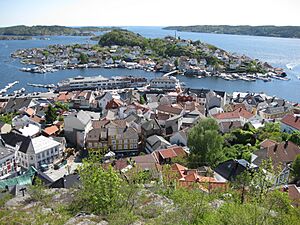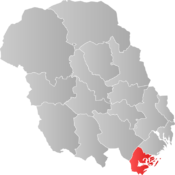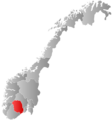Kragerø facts for kids
Quick facts for kids
Kragerø kommune
|
|||
|---|---|---|---|
|
Municipality
|
|||
 |
|||
|
|||

Kragerø within Telemark
|
|||
| Country | Norway | ||
| County | Telemark | ||
| District | Vestmar | ||
| Established | 1 Jan 1838 | ||
| Administrative centre | Kragerø | ||
| Area | |||
| • Total | 305.46 km2 (117.94 sq mi) | ||
| • Land | 288.63 km2 (111.44 sq mi) | ||
| • Water | 16.83 km2 (6.50 sq mi) 5.5% | ||
| Area rank | #262 in Norway | ||
| Population
(2023)
|
|||
| • Total | 10,413 | ||
| • Rank | #111 in Norway | ||
| • Density | 36.1/km2 (93/sq mi) | ||
| • Change (10 years) | -2.7% | ||
| Demonym(s) | Kragerøværing | ||
| Time zone | UTC+01:00 (CET) | ||
| • Summer (DST) | UTC+02:00 (CEST) | ||
| ISO 3166 code | NO-4014 | ||
| Official language form | Neutral | ||
| Created as | Formannskapsdistrikt in 1838 | ||
|
|
|||
Kragerø is a beautiful municipality in Telemark county, Norway. It's located in the traditional areas of Grenland and Vestmar. The main town and administrative center is also called Kragerø. Other villages in the municipality include Helle, Vadfoss, Kil, and Portør.
Kragerø covers about 305 square kilometers, making it the 262nd largest municipality in Norway. It's home to around 10,413 people, ranking it as the 111th most populated. In the past, Kragerø was a very important port city, especially during the time of sailing ships.
Today, Kragerø is a popular vacation spot. Its population grows a lot during the summer because so many tourists visit. The famous artist Edvard Munch loved Kragerø and called it "The Pearl of the Coastal Towns." People are drawn to its forests, fjords, and many islands.
Contents
About Kragerø Municipality
Kragerø became its own municipality on January 1, 1838. It was given self-governing rights because it had been a town since 1666. Over the years, parts of nearby municipalities like Sannikedal and Skåtøy were added to Kragerø. In 1960, the town of Kragerø merged with the entire Skåtøy Municipality and Sannidal Municipality to form the Kragerø municipality we know today.
The Name of Kragerø
The name Kragerø comes from the island of Kragerø. The town was built on this island and the nearby mainland. The old Norse name for the island was Krákarey.
So, Kragerø essentially means "Crow Island." The spelling "Kragerø" uses the Danish form of the name, which became common in the 1600s.
Kragerø's Coat of Arms
Kragerø was given special town rights in 1666. At that time, the town had to provide a special ship called a galley, equipped with five cannons, to the King's navy. For a long time, Kragerø used a seal similar to the nearby town of Skien. But after 1842, Kragerø started using a galley as its symbol.
The official coat of arms for Kragerø was approved on January 28, 1938. It was re-approved in 1960 after the municipal merger. The design shows a silver galley on a black background. A galley is a type of ship, often powered by oars. The municipal flag has the same design as the coat of arms.
Churches in Kragerø
The Church of Norway has five parishes, or local church districts, within the Kragerø municipality. These churches are part of the Bamble deanery.
| Parish | Church name | Location | Year built |
|---|---|---|---|
| Helle | Helle Church | Helle | 1981 |
| Kragerø | Kragerø Church | Kragerø | 1870 |
| Levangsheia | Støle Church | Støle | 1892 |
| Sannidal | Sannidal Church | Kil | 1772 |
| Skåtøy | Skåtøy Church | Skåtøy | 1862 |
Geography and Nature
Kragerø is the southernmost municipality in Telemark county. It shares borders with Risør and Gjerstad to the southwest and west. To the northwest is Drangedal, and to the northeast is Bamble.
This area is very popular for vacations, especially in the summer. Kragerø is known for its beautiful coastline. It has 495 islands, small islands, and rocky islets. There are also about 4,000 vacation homes here. The municipality also has 190 freshwater lakes.
Some of the main islands offshore include Tåtøy, Kragerø, Skåtøy, Langøy, Bærøy, Gumøy, Stråholmen, and Jomfruland. You can also find the Fossingfjord and Kilsfjord in Kragerø. Part of the large lake Toke is located in the northern part of the municipality.
Famous People from Kragerø
Many interesting people have come from Kragerø. Here are a few:
- Anton Martin Schweigaard (1808–1870), a legal expert and economic reformer.
- Theodor Kittelsen (1857–1914), a famous painter who illustrated fairy tales and trolls.
- Hans Daae (1865–1926), a doctor, military officer, and sports official.
- Kirsten Heiberg (1907–1976), a Norwegian and German actress and singer.
- Else Heiberg (1910–1972), an actress.
- Alf Cranner (1936–2020), a folk singer, songwriter, and painter.
- Robert Mood (born 1958), a Major General who led a United Nations mission.
Sports Figures from Kragerø
Kragerø has also produced talented athletes:
- Olaf Ørvig (1889–1939), a sailor who won a gold medal at the 1920 Summer Olympics.
- Knut Lundstrøm (born 1951), an athlete who competed in the Paralympics.
- Preben Fjære Brynemo (born 1977), a Nordic combined skier who competed at the 2002 Winter Olympics.
International Connections
Kragerø has "twin towns" or "sister cities" in other countries. These connections help build friendships and cultural exchange between different places.
Twin Towns and Sister Cities
Kragerø is twinned with the following cities:
 Mariehamn, Åland, Finland
Mariehamn, Åland, Finland Slagelse, Region Sjælland, Denmark
Slagelse, Region Sjælland, Denmark Valkeakoski, Western Finland, Finland
Valkeakoski, Western Finland, Finland Visby, Gotland County, Sweden
Visby, Gotland County, Sweden
Images for kids
See also
 In Spanish: Kragerø para niños
In Spanish: Kragerø para niños







